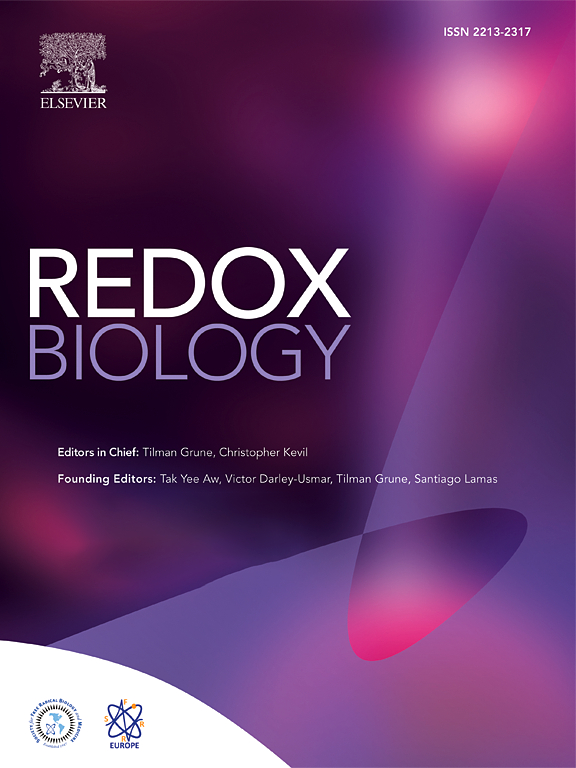支链氨基酸通过抑制蛋鸡的新脂肪生成和激活脂肪酸β-氧化来缓解非酒精性脂肪肝。
IF 11.9
1区 生物学
Q1 BIOCHEMISTRY & MOLECULAR BIOLOGY
引用次数: 0
摘要
支链氨基酸(BCAA)对新陈代谢的不良影响已被阐明是由异亮氨酸和缬氨酸介导的。限制异亮氨酸的膳食可促进代谢健康并延长寿命。然而,富含 BCAA 的高蛋白饮食是目前治疗非酒精性脂肪肝(NAFLD)最有用的策略,但其基本机制仍不为人知。脂肪肝出血性综合征(FLHS)是一种特殊的蛋鸡非酒精性脂肪肝模型,在高能量和高蛋白饮食背景下,可自发形成脂肪肝和肝脏脂肪变性,其发病机制与人类非酒精性脂肪肝相似。日粮 BCAA 控制蛋鸡非酒精性脂肪肝发生的机制仍不清楚。在此,我们证明日粮中补充 67% 的高 BCAA 对蛋鸡非酒精性脂肪肝有独特的缓解作用。高 BCAA 日粮通过抑制色氨酸-ILA-AHR 轴和 MAPK9 介导的新生脂肪生成(DNL)、促进酮生成和能量代谢、激活 PPAR-RXR 和 pexophagy 以促进脂肪酸 β 氧化,从而缓解非酒精性脂肪肝。此外,我们还发现高 BCAA 可通过下调 UFMylation 强力激活泛素-蛋白酶体自噬,从而触发 MAPK9 介导的 DNL、脂肪酸伸长和脂滴形成相关蛋白泛素化降解,激活 PPAR-RXR 和 pexophagy 介导的脂肪酸 β 氧化和脂肪分解。总之,我们的数据强调,通过抑制AHR/MAPK9来调节高BCAA的摄入量是治疗非酒精性脂肪肝和FLHS的有前途的新策略。本文章由计算机程序翻译,如有差异,请以英文原文为准。
Branched-chain amino acids alleviate NAFLD via inhibiting de novo lipogenesis and activating fatty acid β-oxidation in laying hens
The adverse metabolic impacts of branched-chain amino acids (BCAA) have been elucidated are mediated by isoleucine and valine. Dietary restriction of isoleucine promotes metabolic health and increases lifespan. However, a high protein diet enriched in BCAA is presently the most useful therapeutic strategy for nonalcoholic fatty liver disease (NAFLD), yet, its underlying mechanism remains largely unknown. Fatty liver hemorrhagic syndrome (FLHS), a specialized laying hen NAFLD model, can spontaneously develop fatty liver and hepatic steatosis under a high-energy and high-protein dietary background that the pathogenesis of FLHS is similar to human NAFLD. The mechanism underlying dietary BCAA control of NAFLD development in laying hens remains unclear. Herein, we demonstrate that dietary supplementation with 67 % High BCAA has unique mitigative impacts on NAFLD in laying hens. A High BCAA diet alleviates NAFLD, by inhibiting the tryptophan-ILA-AHR axis and MAPK9-mediated de novo lipogenesis (DNL), promoting ketogenesis and energy metabolism, and activating PPAR-RXR and pexophagy to promote fatty acid β-oxidation. Furthermore, we uncover that High BCAA strongly activates ubiquitin-proteasome autophagy via downregulating UFMylation to trigger MAPK9-mediated DNL, fatty acid elongation and lipid droplet formation-related proteins ubiquitination degradation, activating PPAR-RXR and pexophagy mediated fatty acid β-oxidation and lipolysis. Together, our data highlight moderating intake of high BCAA by inhibiting the AHR/MAPK9 are promising new strategies in NAFLD and FLHS treatment.
求助全文
通过发布文献求助,成功后即可免费获取论文全文。
去求助
来源期刊

Redox Biology
BIOCHEMISTRY & MOLECULAR BIOLOGY-
CiteScore
19.90
自引率
3.50%
发文量
318
审稿时长
25 days
期刊介绍:
Redox Biology is the official journal of the Society for Redox Biology and Medicine and the Society for Free Radical Research-Europe. It is also affiliated with the International Society for Free Radical Research (SFRRI). This journal serves as a platform for publishing pioneering research, innovative methods, and comprehensive review articles in the field of redox biology, encompassing both health and disease.
Redox Biology welcomes various forms of contributions, including research articles (short or full communications), methods, mini-reviews, and commentaries. Through its diverse range of published content, Redox Biology aims to foster advancements and insights in the understanding of redox biology and its implications.
 求助内容:
求助内容: 应助结果提醒方式:
应助结果提醒方式:


